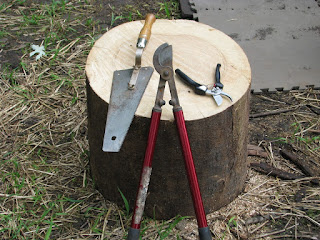Hey guys
its Taylor, I’m back. I wrote the blog about our first real day of field school
working on our and your beloved Fort St. Joseph Archaeological Project. Since
that exciting first day we have all made lots of progress excavating our units
in a slow but sure process. Like I mentioned in my first blog the unit
coordinates for the unit that me and my partner Sami are working on are North 9
East 2. We are currently digging down to thirty five centimeters below our
datum point. After we worked our way down layer by layer we slowly have amassed
many awesome artifacts. There is already a full blog written by my pit partner
about the amazing lead seal we found in our unit on the first week, but that
was just the beginning.
After we found the seal and
continued to dig we found multiple artifacts that are just as if not even more
awesome than the lead seal. The first cool artifact we found after the lead
seal was small in size but not in meaning, which was a tinkling cone we found
while wet screening. Our tinkling cone has a conical shape although not all
tinkling cones are conical they will occasionally be asymmetrical having a
small point on the bottom. Tinkling cones are made of copper or a copper alloy
and were used by Native Americans as a decorative accessory on their clothes
and jewelry. The second artifact we found right after the tinkling cone was a
catlinite pipe bowl fragment that was found while trowel skimming. Catlinite
was named for George Catlin who was a famous painter and author that
specialized in painting Native Americans in the “old west”. Catlinite is a fine
grained sedimentary rock that is often brownish-red in hue.
The second
week of field school we found a copper ring while trowel skimming. Copper rings
have been found at Fort St. Joseph before and were previously believed to be
French Jesuit rings. The story being that Jesuit priests would give them out to
award people who converted like some Natives did. The fact of the matter is
that we are trying to move away from associating these copper rings exclusively
to Jesuits because it was not only Jesuits who brought these rings from France.
Other French non Jesuit people also brought them to trade with Natives. Our
ring was generally small in diameter and did not have any obvious iconography
on it, just a band. In the same week we found another amazing copper artifact.
The artifact was a triangular shape made up off three copper circles with what
looks like stones but is actually cut glass in each copper circle. The cut
glass, like the oxidized copper, is green and we think it may have been a part
of a cross off a rosary or some type of jewelry.
This week
we have found two more amazing artifacts. The first artifact we found was an
awesome type of bead called a raspberry bead. The bead is blue and translucent
and relatively large compared to the other types of beads we have been finding
like seed beads which are appropriately named for their extremely small size.
The specific reason for calling the bead a raspberry bead is because since they
are made from blown glass the maker will use a technique resulting in a bumpy
pattern on the outside of the bead much like a raspberry.
Right after we found
the raspberry bead in the wet screen, and I mean right after, we found another
lead seal! I could not believe It but there it was. Just like the first one it
was a lead disk with non-uniform edges. One side had a protrusion indicating it
was most likely the back while the other side had some inscription that I could
not make out but nonetheless it was another seal.
Although
we can learn a lot about what the artifacts are made of and there size and what
level of the unit they came from that is not the most important thing we can
learn. The most important thing we can try and take away from our artifacts is
what they indicate was going on in the past. We can take the raw data from the
artifacts and with quality deep thinking we can recreate a picture of the past.
For example, the tinkling cone, we can learn its size and what it is made of
but, we can also try and learn how they were being used in day to day life
during Native and French occupation. We can ask questions like who was making
the tinkling cones, how were they making them, how were they were being used,
and who was using them? These types of thoughtful questions about the past
paired with raw information learned from the uncovered artifacts is how we can
successfully create an accurate depiction of day to day life in the past.
I
am very fortunate to be excavating the area that I am and I am also very
fortunate to be excavating at Fort St. Joseph. Not one day has gone by that we
have not found something from the time of French occupation and I know this is
not the case with every unit and certainly not the case with all archaeological
field work. As much credit as we can take for finding these awesome artifacts
it is really all the previous work others have done from the Niles and field
school communities that allows me and my pit partner to be so fortunate. All
the information gathered over the years has put us in the position to be told
where to dig and be successful no questions asked and that is no small task.
Because of this I must thank all the students, staff, and community members
that have made this success possible. You have made our field school
interesting and fun and worth it, thank you.










